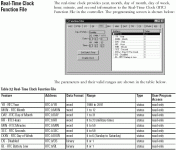Robert J
Guest
R
Hello,
I am "trying" to write code in RSLogix500 for Micro 1500 to determine when a machine has been powered down (main power killed) on one shift and powered up on another shift. The reason for doing this is to reset data if it has went through a shift change. The biggest problem that I am having is our 3rd shift goes through midnight. This means to me that I need to account for a change in month, day and year. Our plant should never work on New Years Eve but I wanted to include it just in case. I have also thought about "cheating"/offsetting the times so that all three shifts occur during the same day. Any advice would be helpfull.
Thank you,
Robert
I am "trying" to write code in RSLogix500 for Micro 1500 to determine when a machine has been powered down (main power killed) on one shift and powered up on another shift. The reason for doing this is to reset data if it has went through a shift change. The biggest problem that I am having is our 3rd shift goes through midnight. This means to me that I need to account for a change in month, day and year. Our plant should never work on New Years Eve but I wanted to include it just in case. I have also thought about "cheating"/offsetting the times so that all three shifts occur during the same day. Any advice would be helpfull.
Thank you,
Robert





